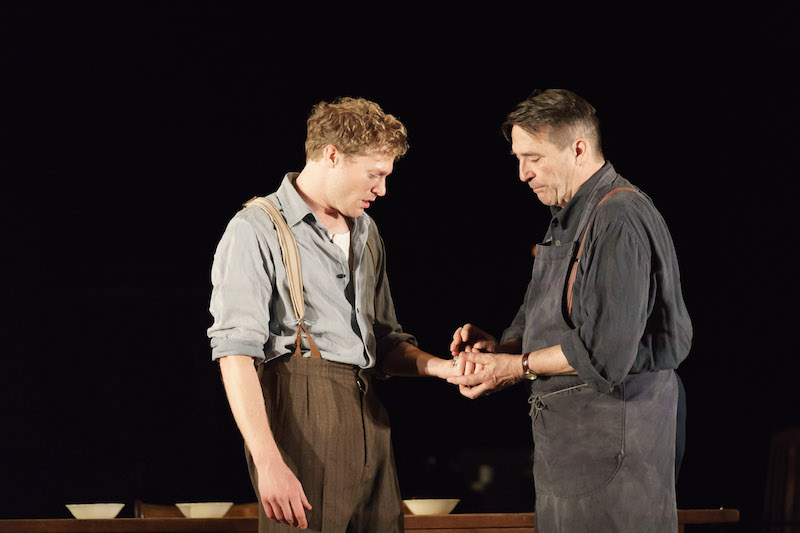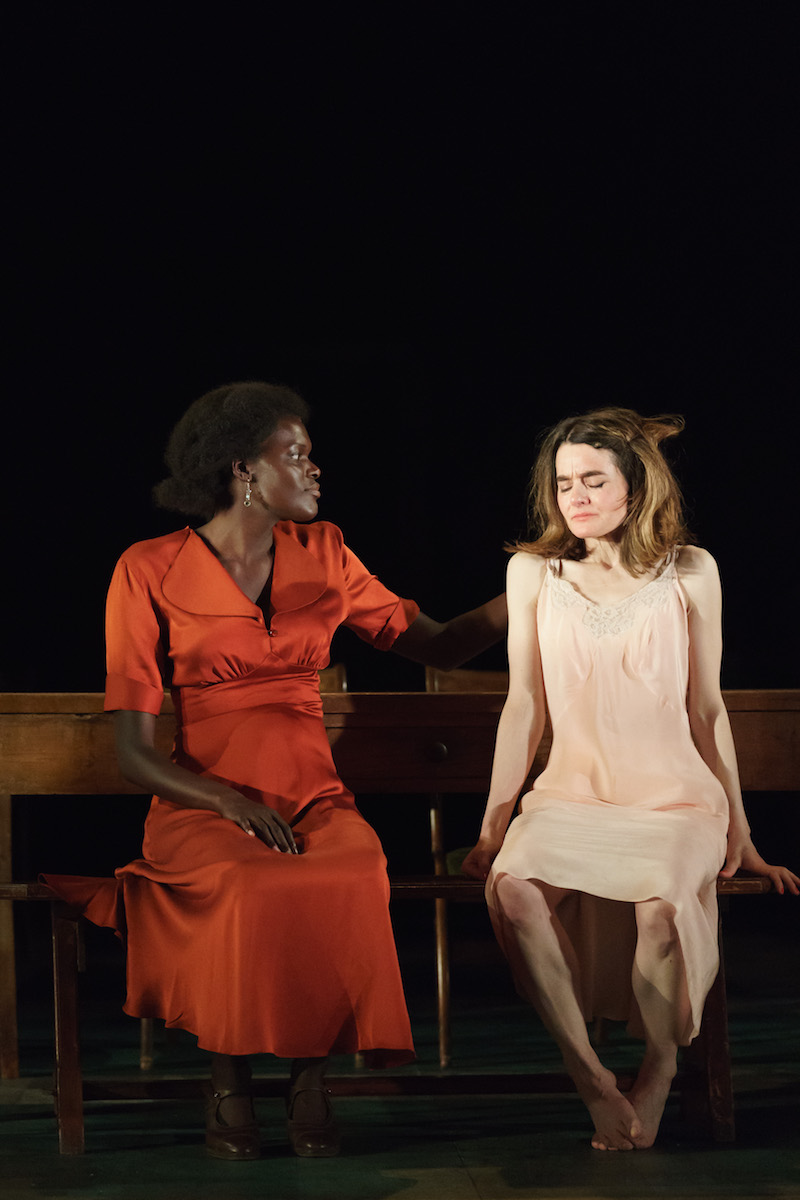The rolling stone is now at home in the West End, as Conor McPherson’s inimitable dramatic take on Bob Dylan transfers from the Old Vic, where it premiered last summer. Described as “a play with songs”, it’s the distinct harmony of two art forms, rather than straining one to incorporate the other in the usual jukebox musical fashion – and the resulting soulful tapestry allows form to articulately reflect its iconic inspiration.
Set in Dylan’s hometown of Duluth, Minnesota, in the Depression-era 1930s, writer/director McPherson gathers a desolate gaggle of folks in a rundown guesthouse: owner Nick Laine (Ciarán Hinds, pictured below with Sam Reid), struggling to stay afloat; wife Elizabeth (Shirley Henderson), suffering from dementia; their hard-drinking son Gene (Sam Reid) and mysteriously pregnant adopted daughter Marianne (Sheila Atim); plus numerous guests and neighbours – all running from creditors, the past, or an inevitable fate. The sheer size of the ensemble, and the use of almost mythic archetypes, renders the characterisation more of a breadth-not-depth affair. The boozy writer longing for escape (“Hemingway”, sniffs his father derisively) is instantly recognisable; this iteration doesn’t stray far from tradition. Nor does the devious bible salesman, wronged boxer, sidelined mistress, local doctor spouting Thornton Wilder-esque narration, or family with a deep, dark secret. Some revelations are explosive; others, infuriatingly, simply dissipate.
The sheer size of the ensemble, and the use of almost mythic archetypes, renders the characterisation more of a breadth-not-depth affair. The boozy writer longing for escape (“Hemingway”, sniffs his father derisively) is instantly recognisable; this iteration doesn’t stray far from tradition. Nor does the devious bible salesman, wronged boxer, sidelined mistress, local doctor spouting Thornton Wilder-esque narration, or family with a deep, dark secret. Some revelations are explosive; others, infuriatingly, simply dissipate.
Yet the music transcends these narrative bumps, making the familiar feel epic, and the sketchy stirringly poetic. Around 20 songs – from across the Dylan decades – form the backbone of the show, with the actors mostly singing straight out to the audience while clasping vintage mics, accompanied by an onstage, period-appropriate band. There are some literal links (of course the boxer heralds “Hurricane”), but the most effective choices, gorgeously arranged by Simon Hale, instead catch onto a mood, thought or feeling – music suddenly illuminating drama via a sideways glance, and vice versa.
Desire and frustration war in “Went to See the Gypsy”, as a widow (the passionate Debbie Kurup) – waiting for a promised inheritance, and for her lover to make up his mind – stirringly vents, while the golden-voiced Atim (pictured below with Shirley Henderson) draws every ounce of longing from “Tight Connection to My Heart”. Her fascinating character, Marianne, a black child adopted by a white family, particularly suffers from the hazy storytelling, but in such musical moments, she crystalises perfectly.
 Music, too, emphasises the themes of ambiguity of action, and the complexity of humanity. Jack Shalloo’s childlike Elias is a confident charmer when belting out “Duquesne Whistle”; Bronagh Gallagher’s previously affluent wife forced into begging for extended credit reveals more bitter and clear-eyed depths through her powerhouse vocals and drumming; Arinzé Kene’s prickly, exasperated boxer becomes focussed and commanding. Claudia Jolly’s sweetheart Kate – neatly accessorised in matching blues, in contrast to the shambolic Gene – complements him so exquisitely in song that her loss is felt. Dramatically, her hasty disappearance is a flaw; musically, it’s a corresponding ache.
Music, too, emphasises the themes of ambiguity of action, and the complexity of humanity. Jack Shalloo’s childlike Elias is a confident charmer when belting out “Duquesne Whistle”; Bronagh Gallagher’s previously affluent wife forced into begging for extended credit reveals more bitter and clear-eyed depths through her powerhouse vocals and drumming; Arinzé Kene’s prickly, exasperated boxer becomes focussed and commanding. Claudia Jolly’s sweetheart Kate – neatly accessorised in matching blues, in contrast to the shambolic Gene – complements him so exquisitely in song that her loss is felt. Dramatically, her hasty disappearance is a flaw; musically, it’s a corresponding ache.
But best of all is Henderson. Riveting even when Elizabeth is peripheral to the action, she creates a detailed portrait of someone lost inside themselves: sometimes feral or infantile, sometimes inappropriately sexual, and then startling in her sage lucidity. In song, she’s a swaggering, all-knowing rock star – playfully nailing “Like a Rolling Stone”, heartrendingly eloquent in “Forever Young”. Hinds’s seemingly stoic but haunted Nick doesn’t sing; instead, the rare quiet moments where he stops bustling and babbling speak volumes.
Of the new cast, Adam James doesn't match Ron Cook’s mature authority as the yarn-spinning doctor; Finbar Lynch could be more slippery as the devilish man of god; and, as the unpredictable Mr Burke, David Ganly lacks Stanley Townsend’s all-important hint of icy ruthlessness. But the ensemble as a whole is superbly drilled by McPherson and movement director Lucy Hind: seamlessly linking vignettes, creating striking tableaux, toe-tapping group elation and spine-tingling harmonies, and adding to the pervading sense of a liminal netherworld – a purgatory of sorts, until its inhabitants find a way to break their stasis.
Dying is described as like stepping “through a glass wall”, and Rae Smith’s designs include wonderful translucent flats. Religious iconography also seeps through: a picture of telegraph poles dominating like giant crosses; a table laid like the Last Supper. If necessarily more compact than the Old Vic staging – and thus losing the beautiful strangeness of a wide-open space – there’s a stronger sense of connection that helps combat the chillier elements of this dreamlike drama, and bolsters the gentle sentiment that to soldier on, with and for one another, through pain, uncertainty, hardship and disillusionment, is a special kind of heroism.














Add comment